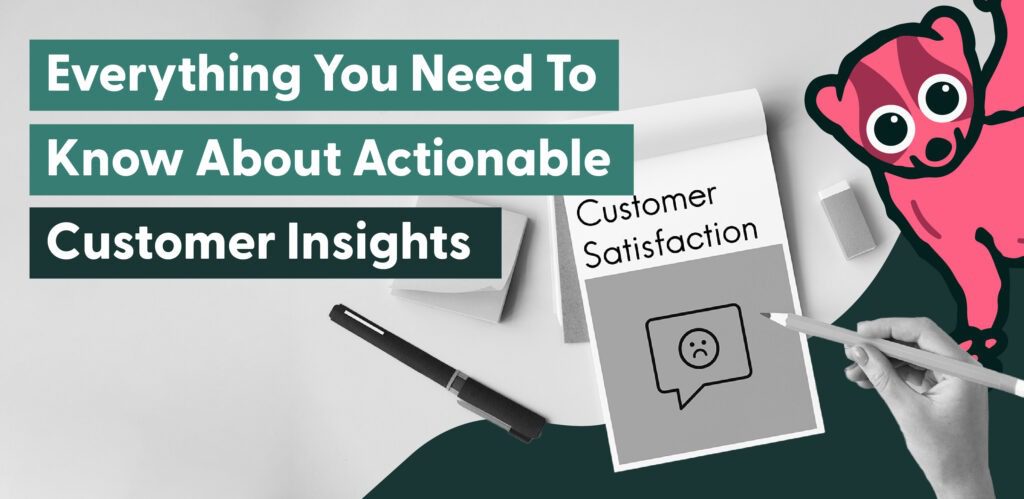
Your customer support team is the heart of your business. It’s where you get invaluable feedback that you can use to improve your product and business to keep your customers happy.
The feedback you get through your contact center can become actionable insights if you use it correctly.
But what makes customer insights actionable, and what does this mean in customer service?
In this article, we’ll guide you through what actionable insights are, how to use them to make improvements, and how to turn data into tangible changes.
What Are Actionable Insights In Customer Support?

Actionable insights are when you use customer service data to identify tangible changes that you can make to improve your business.
Actionable insights are about how you use data. Data isn’t only about reporting and measuring how your contact center is performing. It’s about applying customer insights to your entire business to make improvements.
For example, if your feedback shows that customers are complaining about email response times, you can take action based on this insight. You could allocate more staff to your email customer service team and measure your response times or provide more self-service options on common email topics.
Like what you're reading? Get the latest articles, product updates, and industry news in the Loris newsletter.
What Makes Insights Actionable?

There are certain criteria that data and analysis should meet if it’s going to be used as actionable insights. An actionable insight is:
👉 Relevant
Actionable insights should be directly related to the goals and objectives of a business. They are relevant to the actions that the business can take to achieve these goals. One goal could be retaining customers rather than having to acquire new ones.
An actionable insight connected with this might be that your renewal costs are too high. You could take action by reducing your costs or introducing a loyalty scheme for existing customers.
👉 Clear
Insights should be presented in a clear and understandable manner. This ensures that decision-makers within your business can easily understand the information and act on it. If data is too vague, it’s difficult to take action.
👉 Timely
The information should be timely to allow your team to respond to changing circumstances. An insight delivered too late has less value.
Acting fast on analyzing data is critical if you want your actionable insights to work.
👉 Specific
Actionable insights provide details on exactly what happened and what needs to change. They go beyond general trends or observations to offer practical guidance.
👉 Measurable
Insights should be measurable so you can measure the impact of your actions and the issues you address.
👉 Actionable
The most crucial aspect is that the insights should suggest clear actions. They should guide decision-makers on what steps to take to act on opportunities or address challenges.
How Actionable Insights Impact Customer Support

Although actionable insights should be applied to your entire business, let’s look at how they would impact your customer support department:
✅ Connect data with decision making
The right insights help contact center managers and customer experience (CX) leaders make data-driven decisions rather than making assumptions. The right insights take the guesswork out of deciding what needs to be improved within your customer service team.
Actionable insights don’t just give you data to work with. They give you practical things you can do to improve data points.
✅ Improve efficiency
Insights will reveal where you can improve your customer support processes to streamline customer interactions. You’ll know what your customers complain about most, meaning you can provide your agents with resources to resolve these complaints quickly.
✅ Inform agent training and coaching
Having customer insights is great. But if you don’t use them to inform your coaching and training programs for your agents, you’re missing out on a massive opportunity—at least, that’s our philosophy.
With these insights, you can coach your agents on how to fix real issues that customers are contacting you about rather than providing general training on how to do their jobs.
✅ Understand your customers
How will you give your customers what they want if you don’t understand them? With actionable insights, you’ll know how to overcome their pain points, adjust to their preferences, and avoid common complaints
✅ Improve customer retention and loyalty
Actionable insights help you enhance the customer experience. You can anticipate and address customer needs and pain points proactively. This helps you retain customers and earn their loyalty.
✅ Gain a competitive advantage
Many of your competitors may not be using data effectively (or at all). This means they don’t get a clear idea of how to improve their business. You’re gaining an advantage over your competitors by using data and deriving actionable insights. In fact, you can even track competitive mentions in your own customer interactions to get free competitive intel from each conversation.
Where to Get Customer Insights

Actionable insights start with data. Here are some of the ways you can gather data to analyze and generate actionable insights.
➡️ Customer feedback surveys
Customer surveys provide you with qualitative customer feedback. They give you data that you can analyze to uncover trends and patterns in customer behavior, preferences, and satisfaction levels.
Surveys like net promoter score (NPS) can help you measure customer satisfaction and loyalty and get insight into how customers feel about your brand.
If your NPS is low and customers are complaining about your website being difficult to navigate, the actionable insight is that you need to improve your site’s usability.
➡️ Customer interviews
You can also collect customer insights by speaking directly with your customers. This could be through follow-up calls after a customer interaction or even focus groups.
You may also want to ask customers open-ended questions to allow them to share detailed feedback about their experience with your brand.
If customers mention in your interviews that they find it hard to contact your support department, an actionable insight would be creating more channels for customers to contact you.
➡️ Customer interactions
Your calls, emails, and live chats are a rich source of actionable customer insights. The problems and inquiries your customers contact you with tell you what needs fixing to ensure customer satisfaction.
If your customer interactions show that your deliveries are taking too long, an actionable insight would be investigating if there are any issues with your delivery partners.
➡️ Website analytics
You can gather actionable insights from your website analytics by using analytics platforms. For example, you can observe the users on your website in real time using tools like FullStory, Mouseflow, or Inspeclet. This can give you feedback on how users navigate your website.
It can also highlight usability issues or what’s getting in the way of completing a purchase. Could it be delivery options that customers don’t like? Is your checkout process too complex? An actionable insight would be reviewing the customer journey on your website to ensure they can complete a purchase easily.
💡 Remember, This Is Just Feedback
It’s important to keep in mind that using these methods will help you gather customer feedback, not insights. It’s analyzing this feedback that will get you actionable insights.
Understanding Bias When Analyzing Customer Data
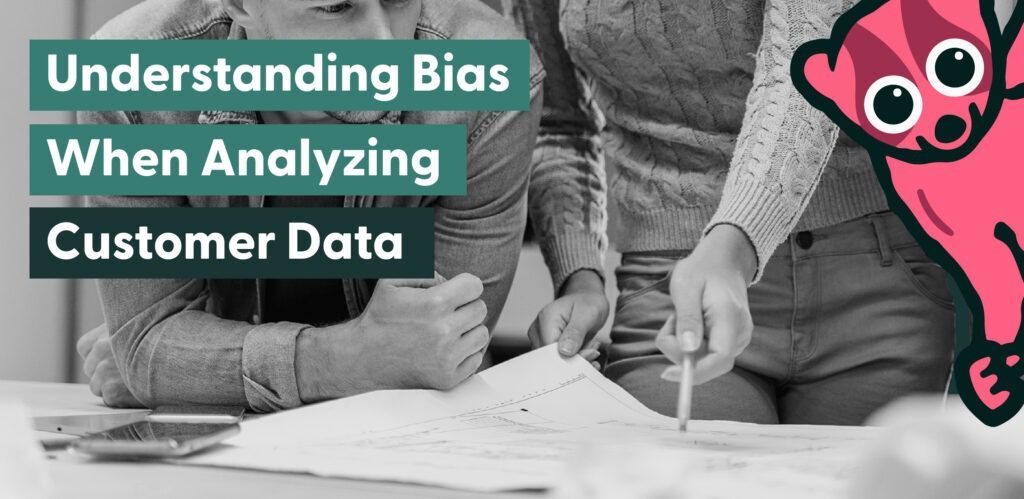
Before you start gathering customer insights, it’s important to be aware of customer survey bias. Customer bias can lead to:
- Skewed survey results.
- Inaccurate data.
- Misleading customer feedback analysis results.
There are two main types of bias to be aware of when you survey or speak to your customers:
🤔 Sampling bias
This is when the group of customers you’re surveying or interviewing doesn’t represent your customer base accurately.
If you conduct a survey only with customers who have recently made a purchase, you might miss the opinions of those who have chosen not to continue using your product.
You’ll see sampling bias in action if only a certain percentage of customers respond to your surveys (say 20%) rather than everyone you sent the survey to (100% of your customer base).
🤔 Response bias
This happens when customers provide answers they think are expected or acceptable rather than sharing their true thoughts or feelings.
During interviews, customers may rate your product higher than they actually feel because they want to be polite or avoid an uncomfortable situation.
Another way you may run into response bias is by sending out lengthy surveys. Your customers may answer the last questions inaccurately just to finish the survey and claim any rewards you may be offering.
How to Make Customer Insight Actionable
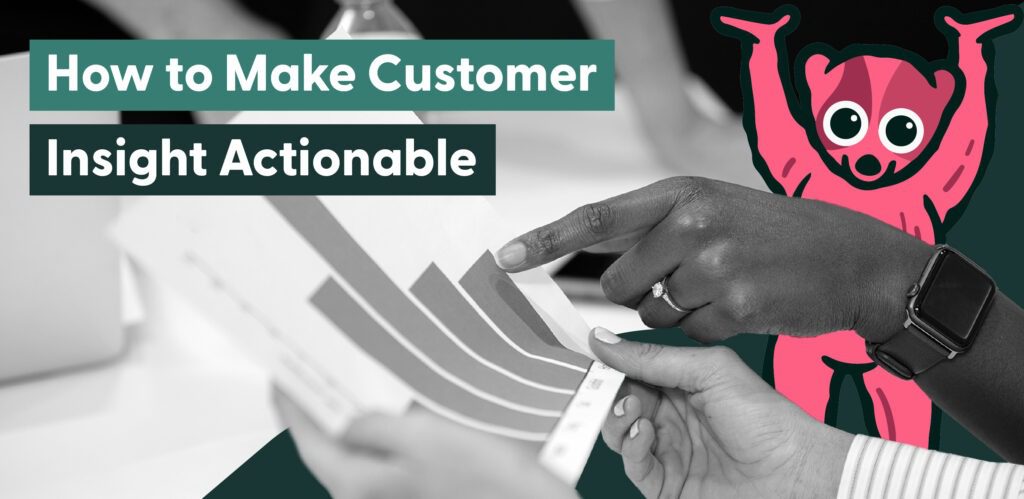
Here are some examples of how you can take customer feedback and make it actionable:
Feedback | Action |
Customers contact support for help using a feature they could not figure out themselves. | Send this feedback to your product development team to help them understand how to make the feature more straightforward to use or create helpful documentation. |
Customers contact support because a bug prevents them from achieving a goal. | Identifying this emerging issue quickly means you can make fixing this bug a priority. |
Customers contact support because your product lacks a feature that would help them achieve a goal. | You share this insight with your product team so they can incorporate it into your product strategy and consider adding this feature. |
Customers contact support to complain about a policy that is unclear or is not customer-friendly. | You could consider changing the policy or re-wording it so that it’s easier for your customers to understand. |
Taking an Actionable Insights Approach to CX Strategy

Here’s an example of what an actionable insights approach to CX might look like.
Let’s say your company provides a service that helps customers with payments and invoices. You provide software that customers can use to send and receive payments.
You’ve received a high number of users complaining that their vendors haven’t received payments and are asking you to track them.
Here’s how your CX team can take action:
- To decrease the chance of similar complaints in the future, you can investigate if there are delays in deliveries of payments. You can also ensure that customers can track the status of their payments.
- To make sure that agents can resolve complaints like this one faster—and satisfy the customer—you can ensure agents have access to tools that allow them to look up a payment and tell the customer its status.
- Also, agents should know how to answer the “Can we track payment?” question. You can provide them with coaching to help them do this.
Using Contact Drivers to Make Insights Actionable
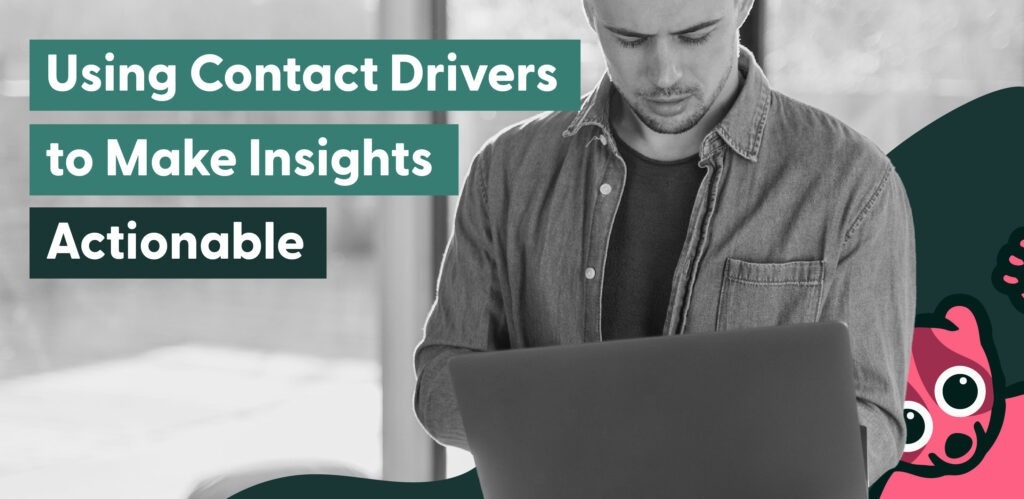
A Contact Driver refers to the issue, question, or need that prompts a customer to contact your support center. Understanding Contact Drivers can help you identify common reasons why customers seek support.
Automatically classifying support tickets with specific contact drivers gives you actionable insights from your customer interactions, which can help drive your CX strategy.
For example, using Contact Drivers, you can easily see all the tickets where customers complained about a product feature not working, such as an “X feature error.” This would enable you to quickly identify a common issue and treat all these conversations as a group.
You can then analyze these groups to see:
How many of these complaints occur each week or month
How much time your agents spend on resolving these complaints
What the average customer satisfaction (CSAT) score is for these tickets.
When you reach out to your product development team about this issue, the first question they’ll likely ask you is how often this problem happens. Contact Drivers allow you to easily answer this question and give tangible evidence that it’s worth addressing.
Use AI to Generate Actionable Customer Insights

Traditional quality assurance (QA) tools only provide a sample of customer service data, leading to incomplete and inaccurate information. This can result in the wrong actions being taken or taking to long to understand common issues.
If you want truly actionable customer insights, you need to collect and analyze every single customer interaction across your contact center.
However, to analyze every interaction yourself is a massive (and pretty much impossible) task. Humans alone aren’t great at analyzing huge data sets and spotting patterns and trends.
This is where artificial intelligence (AI) is useful. An AI-powered conversation intelligence platform can analyze your customer interactions and provide insights that help you understand your customers. This allows you to make tangible improvements to your entire company.
Powered by AI, Loris analyzes every customer interaction across all your support channels. Our platform then identifies trends, patterns, and issues arising in real time. You can act on these insights immediately, keeping your customers happy 24/7.
The Benefits of Using AI to Gather Insightful Data
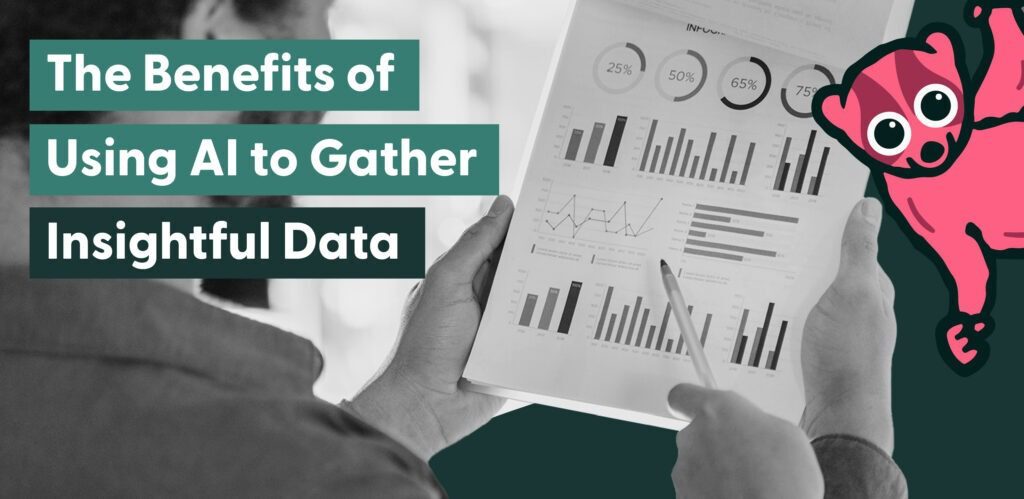
Now that you know how AI tools can help you analyze your customer interactions, let’s look at how a platform like Loris can benefit your customer support center and your business as a whole:
🏆 More granular data
The data you get when you use an AI conversational intelligence platform gives you more in-depth data than traditional quality assurance (QA) tools. By extracting keywords from customer interactions, you can understand customer issues in greater detail.
🏆 Less manual effort
You don’t need your customer experience team to contact customers and collect their feedback manually. They also don’t have to try to analyze this feedback. AI does it all.
We’re not saying you should fire your CX team (please don’t!) if you decide to use AI, but they could better use their expertise to implement the actionable insights they get.
🏆 Actionable suggestions
AI platforms can provide suggestions on what you need to fix or improve within your customer service department and your business as a whole. These suggestions become actionable insights—voila!
Your Best Friend for Actionable Customer Insights
Having actionable customer insights is invaluable to your contact center and your entire business. These insights help with efficiency, making better decisions, and improving customer retention.
However, without the right platform, you won’t get insights that are in-depth enough for you to make real changes. You’ll also have to analyze data manually.
Loris is a conversational intelligence platform that uses AI to analyze all your customer interactions and provide you with actionable insights. Our platform does this without QA managers or CX leaders having to collect and analyze data.
We’d love to show you Loris in action. Schedule time with a Loris expert and see how our platform can provide you with the best actionable insights.